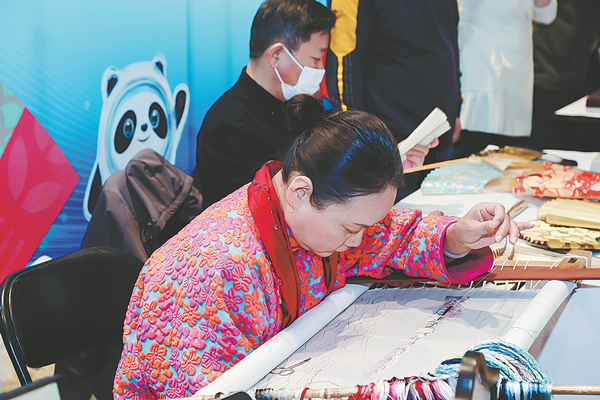

Zou's Su embroidery works are being shown during Suzhou Arts and Culture Week highlighting the culture of Suzhou in Beijing from Thursday to Jan 20. The event is part of the 22nd Meet in Beijing International Arts Festival, which kicked off on Thursday and runs until Feb 18.
The festival, with an aim to celebrate the upcoming Beijing Winter Olympics and Winter Paralympics, includes a series of cultural and artistic activities like a grand gala, dramas, exhibitions and dances.
Famous for its history and culture, Suzhou was admitted to the UNESCO Creative Cities Network as a capital of crafts and folk arts in 2014. The city has six items that were each listed as an Intangible Cultural Heritage of Humanity by UNESCO. It has many intangible cultural heritage items, including Kunqu Opera, K'o-ssu (Kesi), a traditional type of decorative silk work in China, and guqin (a traditional musical instrument).
As a style of Chinese embroidery, Su embroidery is crafted in areas around Suzhou, and is famous for its meticulous and varied stitching, elegant colors and beautiful patterns. The works Zou brings to Beijing include a wedding dress, perfume satchels and other items showing the culture of Jiangnan (regions south of the Yangtze River) and various techniques of Su embroidery.
Zou showcases the pattern of a lion placing its paw on an embroidered ball that she is showing at the exhibition. This is an auspicious image in China. "In traditional Chinese culture, this pattern often appears as a celebration for festivals or big events, so I want to show it to celebrate the upcoming Olympics," says Zou.
Innovation has been a close companion and, in a very real sense, she is re-creating the craft. She holds several patents for new embroidery techniques she has developed or rediscovered. One in particular is noteworthy. When she embroidered the Dunhuang work, she recovered a technique called "split stitch", which was used in the creation of the original tapestry, but had long been lost. She then made another embroidery piece using the technique and donated it to the National Museum of China.